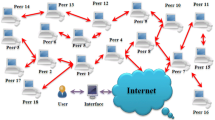Abstract
In this paper we introduce SMoL, a simplified BPEL-like language for specifying peer and service behaviour in P2P systems. We then define a transformational semantics of SMoL in terms of Yet Another Workflow Language (YAWL) workflows, which enables the simulation (e.g., testing possible execution scenarios) and analysis (e.g., verifying reachability or lock freedom) of the behaviour of P2P peers and services.
Similar content being viewed by others
Explore related subjects
Discover the latest articles and news from researchers in related subjects, suggested using machine learning.References
Ratnasamy S, Francis P, Handley M, et al. A scalable contentaddressable network. In: Proceedings of the International Conference of the Special Interest Group on Data Communication, California, United States, 2001, 31(4): 161–172
Albano M, Brogi A, Popescu R, et al. Towards secure middleware for embedded peer-to-peer systems: objectives and requirements. In: Proceedings of the 2nd Workshop on Requirements and Solutions for Pervasive Software Infrastructures. Innsbruck, Austria, 2007
Wil M P van der Aalst, Arthur H M ter Hofstede. YAWL: yet another workflow language. Information Systems, 2005, 30(4): 245–275
Verbeek E, Wil M P van der Aalst. Woflan 2.0: A petri-netbased workflow diagnosis tool. In: Nielsen M, Simpson D, eds. Lecture Notes in Computer Science. Berlin: Springer-Verlag, 2000, 1825: 475–484.
Benigni F, Brogi A, Buchholz J L, et al. Secure P2P programming on top of tuple spaces. In: Proceedings of the Workshop on Coordination Models and Applications: Knowledge in Pervasive Environments, Rome, Italy, 2008
Brogi A, Popescu R, Gutierrez F, et al. A service-oriented model for embedded peer-to-peer systems. In: Proceedings of the International Workshop on Foundations of Coordination Languages and Software Architecture, Electronic Notes in Theoretical Computer Science, 2008, 194(4):5–22
Duran F, Gutierrez F, Lopez P, et al. A formalization of the SMEPP model in Maude. In: Proceedings of the 1st International Workshop on Middleware for Mobile Embedded Peer-to-Peer Systems, Trinity College Dublin, Ireland, 2008
Alda S, Cremers A B. Towards composition management for component-based peer-to-peer architectures. In: Proceedings of Software Composition Workshop, affiliated to European Joint Conference on Theory and Practice of Software, Electronic Notes in Theoretical Computer Science, 2005, 114: 47–64
Bisignano M, Modica G D, Tomarchio O. JMobiPeer: A middleware for mobile peer-to-peer computing in manets. In: Proceedings of the 25th International Conference on Distributed Computing Systems Workshops, 2005, 785–791
Gehlen G, Pham L. Mobile web services for peer-to-peer applications. In: Proceedings of the 2nd Consumer Communications and Networking Conference, 2005, 427–433
Handorean R, Sen R, Hackmann G, et al. Supporting predictable service provision in manets via context aware session management. Journal of World-Systems Research, 2006, 3: 1–26
Lucchi R, Zavattaro G. WSSecSpaces: a secure data-driven coordination service for web services applications. In: Proceedings of Symposium on Applied Computing, 2004, 487–491
Brogi A, Popescu R. From BPEL processes to YAWL workflows. In: Proceedings of 3rd Workshop on Web Service and Formal Methods, Lecture Notes in Computer Science, 2006, 4184: 107–122
Popescu R. Aggregation and adaptation of web services. VDM Verlag, Dr. Müller, 2008, ISBN: 383646280X
Maheshwari P, Kanhere S S, Parameswaran N. Serviceoriented middleware for peer-to-peer computing. In: Proceedings of the 3rd International Conference on Industry Informatics, 2005, 98–103
Arias-Fisteus J, Fernández L S, Kloos C D. Formal verification of BPEL4WS business collaborations. In: Bauknecht K, Bichler M, Pröll B, eds. E-Commerce and Web Technologies. Lecture Notes in Compute Science, Springer, 2004, 3182: 76–85
Hinz S, Schmidt K, Stahl C. Transforming BPEL to Petri Nets. In: Proceedings of the 3rd International Conference on Business Process Management, 2005, 3649: 220–235
Cámara J C J, Canal C, Vallecillo A. Formalizing WSBPEL business processes using process algebra. In: Proceedings of the 4th International Workshop on the Foundations of Coordination Languages and Software Architectures, Electronic Notes in Theoretical Computer Science, 2006, 154(1): 159–173
Author information
Authors and Affiliations
Corresponding author
Rights and permissions
About this article
Cite this article
Brogi, A., Popescu, R. Workflow-based semantics for peer-to-peer specifications. Front. Comput. Sci. China 2, 398–412 (2008). https://doi.org/10.1007/s11704-008-0038-3
Received:
Accepted:
Published:
Issue Date:
DOI: https://doi.org/10.1007/s11704-008-0038-3




